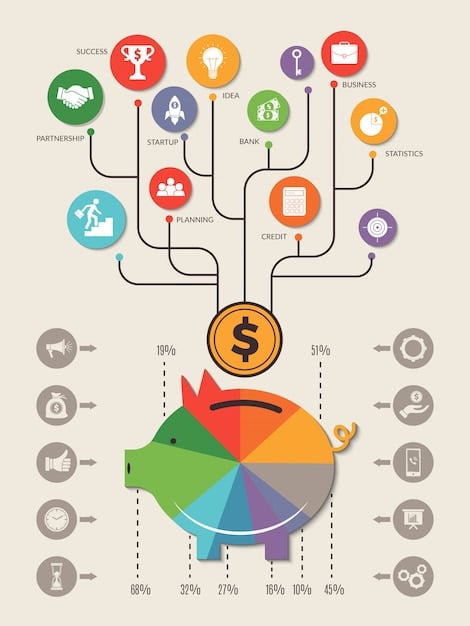Understanding the S&P 500: A Beginner’s Guide to Market Benchmarks

Understanding the S&P 500 is crucial for any beginner investor as it serves as a key indicator of overall market health, reflecting the performance of 500 of the largest publicly traded companies in the US.
Embarking on your investment journey can be both exciting and daunting. Understanding the S&P 500: A Beginner’s Guide to Market Benchmarks is a fundamental step in grasping the broader dynamics of the stock market. Let’s dive in and demystify this crucial index.
What is the S&P 500?
The S&P 500, or Standard & Poor’s 500, is a stock market index that represents the performance of 500 of the largest publicly traded companies in the United States. It is widely regarded as one of the best gauges of overall U.S. equity market health. Understanding its role and function is crucial for anyone learning about the stock market.
Essentially, it’s a benchmark. When you hear news about the market being “up” or “down,” it’s often in reference to the S&P 500. The index is weighted by market capitalization, meaning that larger companies have a greater impact on its performance than smaller ones.
How is the S&P 500 calculated?
The S&P 500 is not simply an average of the stock prices of the 500 companies it includes. It’s a market-capitalization-weighted index, meaning that the weight of each company in the index is proportional to its market cap (stock price multiplied by shares outstanding). This calculation provides a more accurate representation of the market’s overall performance.
What does the S&P 500 tell us?
The S&P 500 is more than just a number; it offers valuable insights into the health of the U.S. economy. A rising S&P 500 generally indicates investor confidence and economic growth, while a declining index may signal concerns about the economy’s future. However, it is important to remember that the S&P 500 is not a perfect predictor, and various factors can influence its performance.
Here are some key insights:
- Economic Health: It acts as a barometer for the U.S. economy, reflecting the financial well-being of leading companies.
- Market Sentiment: It provides a snapshot of investor confidence and risk appetite.
- Investment Performance: It serves as a benchmark for evaluating the performance of investment portfolios.
Understanding the S&P 500 is not just about knowing its definition but also about appreciating its significance in the broader financial landscape. It’s a vital tool for investors looking to make informed decisions.
Why is the S&P 500 important for investors?
For investors, the S&P 500 serves as both a benchmark and an investment opportunity. Its importance stems from its ability to represent the overall market sentiment, provide diversification, and offer a relatively low-cost way to invest in a broad range of leading U.S. companies.
Investing in funds that track the S&P 500 allows investors to gain exposure to a diverse portfolio of companies across various sectors. This diversification can help reduce risk compared to investing in individual stocks.

Benchmarking investment performance
The S&P 500 is primarily used as a benchmark to measure the performance of investment portfolios. Professional and retail investors compare their returns against the S&P 500 to evaluate their investment strategies’ effectiveness. Consistently outperforming this benchmark is often seen as a sign of successful investment management.
Diversification
Another crucial reason for its importance is diversification. By investing in an S&P 500 index fund or ETF, you’re effectively investing in 500 different companies across various sectors. This reduces the risk associated with investing in individual stocks, as the performance of any single company has a limited impact on the overall portfolio.
Consider these points about diversification:
- Sector Exposure: Gain exposure to various sectors, including technology, healthcare, finance, and consumer discretionary.
- Risk Mitigation: Reduce the impact of individual company performance on your overall portfolio.
- Broad Market Coverage: Participate in the growth of the overall U.S. economy.
Investors should understand the importance of the S&P 500 beyond its role as a benchmark. It’s a tool that can enhance portfolio diversification and provide access to the growth potential of the U.S. economy, making it a foundational element in many investment strategies.
How to invest in the S&P 500
Investing in the S&P 500 is a straightforward process, mainly through index funds or Exchange-Traded Funds (ETFs) that mirror the index’s composition and performance. These investment vehicles offer a practical way for investors to gain exposure to the 500 largest U.S. companies without buying each stock individually.
ETFs and index funds are designed to track the performance of the S&P 500, providing returns that closely mirror the index. This makes them inexpensive and efficient for investors seeking broad market exposure.
Understanding index funds
Index funds are mutual funds designed to track a specific index, such as the S&P 500. These funds hold stocks in the same proportion as the index, aiming to replicate its performance before fees and expenses. They are passively managed, which typically results in lower expense ratios, making them a cost-effective option for investors.
Exploring ETFs
Exchange-Traded Funds (ETFs) are similar to index funds but are traded on stock exchanges like individual stocks. S&P 500 ETFs aim to mirror the index’s performance, offering investors the flexibility to buy and sell shares throughout the day. ETFs often have slightly lower expense ratios compared to index funds.

Choosing the right investment vehicle
When choosing between index funds and ETFs, consider factors such as expense ratios, trading flexibility, and investment minimums. While both offer similar exposure to the S&P 500, ETFs provide intraday trading options, while index funds are typically suitable for long-term, buy-and-hold strategies.
Here are some steps to consider when investing in S&P 500:
- Open a Brokerage Account: Choose a brokerage firm that offers access to S&P 500 index funds or ETFs.
- Research Investment Options: Compare different funds based on expense ratios, tracking error, and historical performance.
- Allocate Funds: Determine the appropriate amount to invest based on your risk tolerance and investment goals.
Investing in the S&P 500 through index funds or ETFs is a simple and effective way to diversify your portfolio and participate in the growth of the U.S. economy. Understanding the nuances of these investment vehicles can help you make informed decisions aligned with your financial objectives.
Factors that Influence the S&P 500
The S&P 500 is influenced by a complex interplay of economic, political, and global factors. Understanding these influences can help investors anticipate market movements and make informed investment decisions. Changes in these factors can lead to fluctuations in the index’s performance.
Economic indicators, such as GDP growth, inflation rates, and employment figures, can significantly impact the S&P 500. Positive economic data often leads to investor optimism and drives the index higher, while negative data can trigger sell-offs and declines.
Economic Indicators
Economic indicators provide insights into the health and direction of the economy, which in turn affects corporate earnings and investor sentiment. Key economic indicators that influence the S&P 500 include:
- GDP Growth: A growing economy typically leads to increased corporate profitability and higher stock prices.
- Inflation Rates: High inflation can erode corporate earnings and reduce consumer spending, negatively impacting the S&P 500.
- Employment Figures: Strong job growth boosts consumer confidence and spending, driving economic activity.
Interest Rates
The Federal Reserve’s monetary policy decisions, particularly changes in interest rates, can significantly influence the S&P 500. Lower interest rates can stimulate economic growth by reducing borrowing costs for businesses and consumers, leading to increased investment and consumer spending. Conversely, higher interest rates can slow down economic activity by making borrowing more expensive.
Global Events
Geopolitical events, trade disputes, and international economic conditions can also impact the S&P 500. Global economic slowdowns, trade wars, and political instability can create uncertainty and negatively affect investor sentiment. Events such as Brexit or changes in international trade policies can lead to market volatility.
External factors play a significant role:
- Geopolitical Events: Global events influence investor confidence and market stability.
- Trade Disputes: Trade tensions can disrupt supply chains and impact corporate earnings.
- International Economic Conditions: Economic slowdowns or crises in other countries can affect the S&P 500.
Understanding these factors and their potential impact can enhance your ability to navigate market volatility and make informed investment choices aligned with your long-term goals.
Risks and Limitations of Investing in the S&P 500
While investing in the S&P 500 offers diversification and market exposure, it’s essential to recognize the associated risks and limitations. The S&P 500 is not immune to market downturns and economic challenges, and investors should be aware of these potential pitfalls.
Market volatility is an inherent risk when investing in the S&P 500. Economic downturns, geopolitical events, and unexpected news can lead to sharp declines in the index’s value. Investors should be prepared for potential losses and have a long-term investment horizon.
Market Volatility
Market volatility refers to the degree of variation in trading prices over a period. Higher volatility means that an investment’s price can change dramatically over a short time. The S&P 500, while diversified, is still subject to market swings. Factors contributing to volatility include:
Over Concentration
The S&P 500 is market-capitalization-weighted, meaning that a few large companies can have a disproportionate influence on the index’s performance. This can lead to over-concentration, where a small number of stocks drive the index’s overall returns. If these companies underperform, it can negatively impact the entire index.
Sector-Specific Risks
While the S&P 500 is diversified across multiple sectors, it may still be vulnerable to sector-specific risks. If a particular sector, such as technology or finance, experiences significant challenges, it can drag down the entire index. Investors should be aware of the sector composition of the S&P 500 and potential risks associated with those sectors.
Key limitations to understand:
- Market Downturns: The S&P 500 is subject to declines during economic recessions or market corrections.
- Over-Concentration: A few large companies can disproportionately influence the index’s performance.
- Sector-Specific Risks: Challenges in specific sectors can negatively impact the entire index.
Understanding these risks and limitations is crucial for making informed investment decisions and managing expectations when investing in the S&P 500. Diversification within the S&P 500 can help mitigate some of these risks, but active monitoring of market conditions and portfolio adjustments may be necessary during periods of heightened volatility.
Future of the S&P 500
The future of the S&P 500 is subject to various trends and predictions, influenced by technological advancements, economic shifts, and evolving investor behaviors. Understanding these potential changes can help investors prepare for future market conditions and make informed decisions.
Technological advancements, such as artificial intelligence (AI), automation, and the growth of e-commerce, are expected to continue reshaping industries and impacting the companies within the S&P 500. Companies that embrace and adapt to these technologies may experience growth, while those that lag may face challenges.
Technological Advancements
Technological advancements are transforming industries and business models, influencing the composition and performance of the S&P 500. Companies that innovate and adopt new technologies are likely to thrive, while those that do not may struggle.
Economic Shifts
Economic shifts, such as changes in demographics, consumer preferences, and global trade patterns, can impact the S&P 500. The rise of emerging markets, shifts in consumer spending habits, and changes in government policies can create both opportunities and challenges for companies within the index.
Evolving Investor Behaviors
Changing investor preferences and behaviors, such as the increasing popularity of sustainable investing and the growing influence of millennials and Gen Z in the market, can also shape the future of the S&P 500. Companies that align with these evolving values and preferences may attract more investment.
Key trends to watch:
- Technological Advancements: Artificial intelligence, automation, and e-commerce are reshaping industries.
- Economic Shifts: Demographic changes, consumer preferences, and global trade patterns are evolving.
- Evolving Investor Behaviors: Sustainable investing and the influence of younger generations are growing.
| Key Point | Brief Description |
|---|---|
| 📊 What is S&P 500? | Benchmark of 500 largest U.S. companies, indicating market health. |
| 💰 Investing in S&P 500 | Done via index funds/ETFs, offering diversification and broad market exposure. |
| ⚠️ Risks to Consider | Market volatility, over-concentration, and sector-specific risks exist. |
| 🔮 Future Trends | Impacted by technology, economic shifts, and evolving investor behaviors. |
FAQ
▼
The S&P 500 measures the performance of 500 of the largest publicly traded companies in the United States, offering a broad snapshot of the U.S. equity market’s health.
▼
You can invest in the S&P 500 through index funds or Exchange-Traded Funds (ETFs) that track the index. These funds replicate the index’s holdings, offering diversified exposure.
▼
The main benefits include diversification across 500 companies, low expense ratios, and the potential for long-term capital appreciation mirroring overall U.S. market performance.
▼
Risks include market volatility, economic downturns influencing company performance, and the risk of over-concentration in a few top-performing companies.
▼
The S&P 500 includes 500 companies and is weighted by market capitalization, whereas the Dow Jones includes only 30 companies and is price-weighted, offering different market perspectives.
Conclusion
Understanding the S&P 500 is crucial for any investor looking to grasp the fundamentals of market benchmarks. By providing a broad view of the U.S. stock market, the S&P 500 serves as a valuable tool for benchmarking performance, understanding market trends, and making informed investment decisions. Whether you choose to invest directly through index funds or ETFs, or simply use it as a gauge of market sentiment, the S&P 500 is an indispensable resource for navigating the world of investing.





